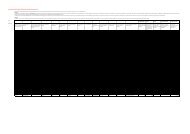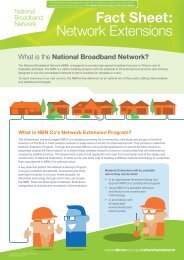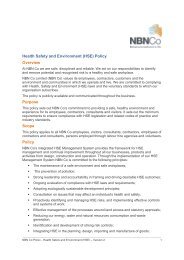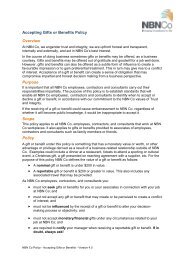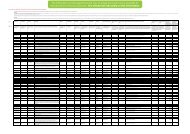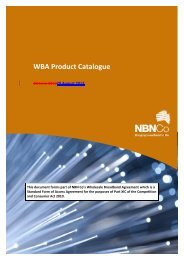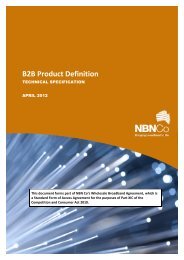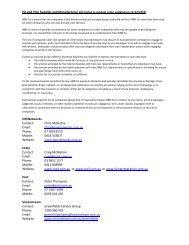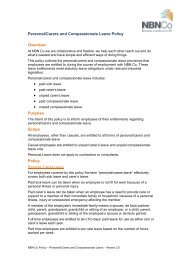NBN Co Network Design Rules
NBN Co Network Design Rules
NBN Co Network Design Rules
Create successful ePaper yourself
Turn your PDF publications into a flip-book with our unique Google optimized e-Paper software.
<strong>NBN</strong> <strong>Co</strong> <strong>Network</strong> <strong>Design</strong> <strong>Rules</strong><br />
The DFN is also required to provide diverse pathways for point to point services from FDHs where<br />
required.<br />
The DFN fibre links cable into the FDH is provided by a single cable and has both A and B directions<br />
within the same cable sheath.<br />
DFN Diversity<br />
The FTTP network has been extensively modelled for availability percentages and expected<br />
downtime due to faults and this modelling has recognized that the DFN has a significant input into<br />
the availability calculations. This is the direct effect of the high fibre counts and distances required<br />
for the DFN.<br />
The availability target indicates that a link distance of 4500 metres can be applied to a single<br />
connection pathway between the FAN and the farthest FDH or to a spur off the DFN without the<br />
need to provide diversity. For practical purposes this distance is reduced to 4000 metres to account<br />
for unforeseen alterations to the network in the construction phase and to provide flexibility for<br />
future maintenance.<br />
This calculation allows the DFN to be installed in topologies other than fully diverse.<br />
The default position for the DFN is to provide connection diversity to each FDH for the provision of<br />
diverse services and to provide the capability for a quicker Mean Time to Repair (MTTR). The quicker<br />
MTTR is achieved through the use of the diverse path available at the FDH to move affected services<br />
to the other “side” of the DFN effectively bypassing the affected cable link.<br />
FDH<br />
FDH<br />
3<br />
4<br />
“A” Direction<br />
FDH<br />
1<br />
FDH<br />
2<br />
FDH<br />
5<br />
FDH<br />
6<br />
FAN<br />
“B” Direction<br />
FDH<br />
12<br />
FDH<br />
11<br />
FDH<br />
8<br />
FDH<br />
7<br />
FDH<br />
FDH<br />
10<br />
9<br />
Direction of traffic to FDH 4 before failure<br />
Change in direction of traffic to FDH 4 after failure<br />
Figure 5 Traffic paths available when failure occurs<br />
The second position is for a collapsible loop (referred to as a return spur) to be installed from the<br />
main diverse DFN, up to 4000 metres, with a maximum of 2 FDHs connected into the return spur.<br />
9



